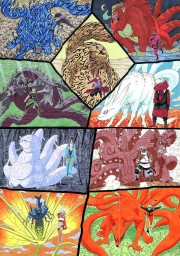| Information contained in this article was retrieved under the Creative Commons Attribution-ShareAlike 3.0 License.
The original article can be found on Narutopedia at Tailed Beasts. |
|---|

The nine tailed beasts.
The tailed beasts (尾獣, bijū) are nine giant demons that serve to drive the plot of the Naruto series. They are differentiated by the number of tails they have, with each possessing a number from one to nine. The tailed beasts are large, living forms of chakra, sometimes referred to as "Chakra Monsters" (チャクラのバケモノ, Chakura no Bakemono),[1] giving them power that far outmatches most shinobi. However, this immense strength is tempered due to their bestial nature, which restricts them from being intelligent enough to use it effectively. When tailed beasts are sealed within humans, they are able to benefit from the knowledge of their hosts, giving them the ability to better utilize their powers.
History
In the beginning of ninja history, centuries before the founding of the ninja villages, there existed one demon, the Ten-Tailed Beast, that plagued the world until the Sage of the Six Paths defeated and sealed the beast within himself, making him the first jinchūriki. However, knowing that his death would release the Ten-Tails back into the world, the Sage used his ability, the Creation of All Things (万物創造, Banbutsu Sōzō), to divide its chakra into the nine other tailed beasts, before using Chibaku Tensei to seal its body away in what would become the moon.[2][3]
The "Process"
How to Challenge a Jinchūriki
In order to challenge a jinchūriki and obtain their respective bijū, one must extend an invitation to the former along with proper arrangements for such an event to take place; should the jinchūriki refuse the set date/time: then negotiate a more appropriate time. However, should the jinchūriki ignore or refuse the invitation(s) (with no authentic reason provided) 3 times consecutively: you may report it to a Game Moderator. Details for the invitation, for both proof and reference of a challenge, must be titled: (Number of tails) - (Name of Jinchūriki); the body of the message may be as you please (although the addition of both manners and politeness would of course make the proceedings run inexcusably smoother).
Should the Bijū be without an existing Host
Should the bijū be sealed within something not a jinchūriki, whomsoever is in possession of the tailed beast (for a prolonged period of one week or more) is entitled to assume duties of fighting for possession of the bijū. In accordance with this: bijū are not to be set free to roam - they must be sealed and delivered to the village of their last jinchūriki.
How to Declare a Winner
The battle commences with the initial post & terminates once either combatant is unable to continue. Such a feat can result in several ways, including knock-outs (concussions, etc.), full paralysis, almost-fatal wounds and so forth. So long as both parties declare it both plausible and understand the longevity/risk of the claim, it is considered eligible for use. However, things can, of course, become debatable in attempt to reach such a goal and in doing so arguments are bound to arise. If need be, either party can have onlookers or Game Moderators /dis/agree with the action until a verdict is reached. If desired, either party can have other hosts or 'officials' represent them for a more "legitimized" (as some have called it) source of reasoning or "Back-up".
Rules
Like any other zone fight, rules are established as support for completing the quarrel without need for troubles to arise. Those basic rules are also adopted into host-challenges. The rules are as follows [unless agreed upon both parties (with proof) to be something otherwise]:
- No Auto-Hitting
Auto-Hitting is recognized as being a direct action following through without consent of the opposing party.
- No God-Modding
God-Modding has been recognized as an incorrect claim of one or more super-powers incapable of one's possession or against what one's character establishes. Several other things have been regarded God-Modding such as dodging every attack through via the execution of maneuvers that the human body is incapable of performing and anything else entirely irrational. If God-Modding should occur, the opposing party may object to it and the two parties may negotiate a verdict from there.
- Hosts May Use Their Tails
There should be no arguments about a host using their bijū's abilities. However, the claim of utilizing all of their tails, if it seems unfit for them, due to period of time with the bijū can be negotiable [but must be maintained only briefly].
Furthermore, other rules can be negotiated between both parties. I.E. Rules such as the number of contestants versus the host [? v. the host (1)] can also be negotiated, etc.
Grace Period
Should the challenger(s) lose to the challenged jinchūriki, a week's grace must be given to the latter before a challenge to a rematch may be issued (this only applies to the losers, the jinchūriki may still be challenged by other parties within the duration of this cool-down period). In cases such as obtaining a bijū for oneself, a fortnight-long is granted in order for the new jinchūriki to “commune” with their bijū. If a host shows inactivity a long period of time (any longer than a fortnight) without prior notice, you can report they are missing and a conference will take place whenever possible to decide upon who a suitable host would be.
Tampering with the Bijū
Tampering with the bijū, meaning: destroying it, altering its affinity, dividing its powers into multiple entities, etc. and any action that changes it from its known canon form is strictly prohibited.
The Tailed Beasts
|





